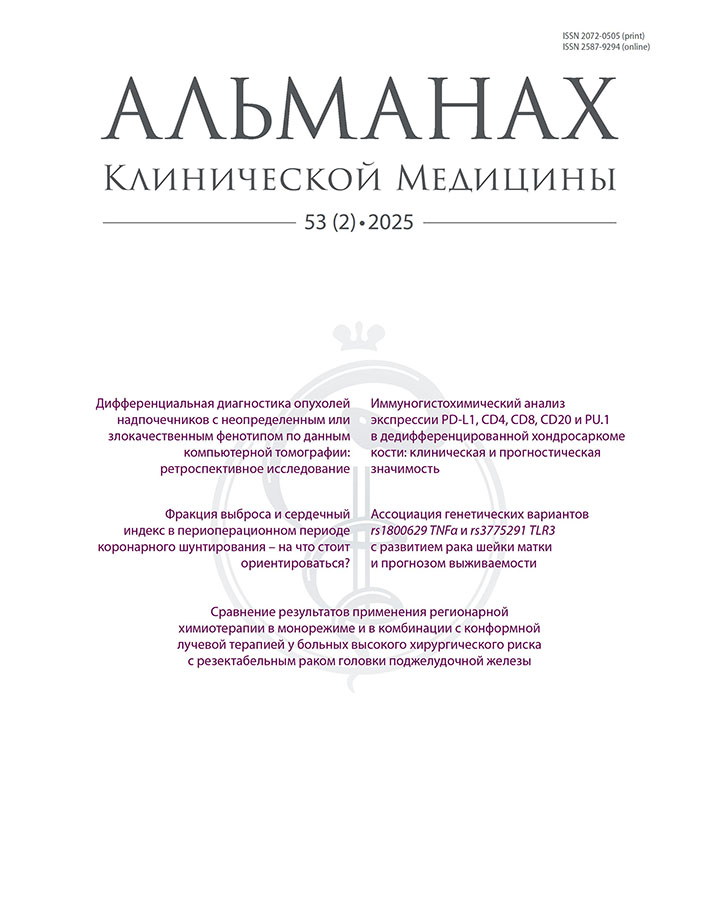ОПРЕДЕЛЕНИЕ ФУНДАМЕНТАЛЬНЫХ ФИЗИЧЕСКИХ ПАРАМЕТРОВ БЕЛКОВ СЫВОРОТКИ КРОВИ ДЛЯ РАЗВИТИЯ МЕТОДОВ ДИАГНОСТИКИ ЗЛОКАЧЕСТВЕННЫХ НОВООБРАЗОВАНИЙ
- Авторы: Гибизова В.В.1,2, Аненкова К.А.1,2, Масленникова А.Д.1,2, Федорова К.В.1,2, Сергеева И.А.1,2, Петрова Г.П.1,2
-
Учреждения:
- ФГБОУ ВО «Московский государственный университет имени М.В. Ломоносова»
- 119991, г. Москва, Ленинские горы, 1, Российская Федерация
- Выпуск: Том 44, № 2 (2016)
- Страницы: 158-164
- Раздел: ОРИГИНАЛЬНЫЕ СТАТЬИ
- URL: https://almclinmed.ru/jour/article/view/332
- DOI: https://doi.org/10.18786/2072-0505-2016-44-2-158-164
- ID: 332
Цитировать
Полный текст
Аннотация
Актуальность. Для медицинской диагностики фундаментальной проблемой является исследование воздействия патологического состояния человека на белки плазмы и сыворотки крови. В качестве диагностических параметров предлагается использовать физические молекулярно-динамические характеристики белков, которые существенно изменяются при развитии болезни. Цель – проведение фундаментальных исследований молекулярных свойств белков сыворотки крови (их подвижность, межмолекулярные взаимодействия, агрегация – образование наноразмерных белковых кластеров, изменение поверхностного заряда и др.) для развития методики диагностики онкологических заболеваний, направленной на создание экспресс-метода на базе лазерного светорассеяния и флуоресценции. Материал и методы. Для определения динамических параметров белков использованы методы лазерного светорассеяния. Результаты. Проведены сравнительные исследования модельных систем и нативных образцов сыворотки крови для диагностики новообразований и рассмотрена возможность применения оптических параметров водных растворов сыворотки крови для создания методов диагностики онкологических заболеваний. Заключение. Методы светорассеяния дают достаточную ин- формацию об изменении статических и динамических свойств белков сыворотки крови при патологии.
Ключевые слова
Об авторах
В. В. Гибизова
ФГБОУ ВО «Московский государственный университет имени М.В. Ломоносова»; 119991, г. Москва, Ленинские горы, 1, Российская Федерация
Email: fedorova@physics.msu.ru
аспирант кафедры молекулярных процессов и экстремальных состояний вещества, физический факультет Россия
К. А. Аненкова
ФГБОУ ВО «Московский государственный университет имени М.В. Ломоносова»; 119991, г. Москва, Ленинские горы, 1, Российская Федерация
Email: fedorova@physics.msu.ru
аспирант кафедры молекулярных процессов и экстремальных состояний вещества, физический факультет Россия
А. Д. Масленникова
ФГБОУ ВО «Московский государственный университет имени М.В. Ломоносова»; 119991, г. Москва, Ленинские горы, 1, Российская Федерация
Email: fedorova@physics.msu.ru
специалист по учебно- методической работе I категории учебного отдела деканата физического факультета Россия
К. В. Федорова
ФГБОУ ВО «Московский государственный университет имени М.В. Ломоносова»; 119991, г. Москва, Ленинские горы, 1, Российская Федерация
Автор, ответственный за переписку.
Email: fedorova@physics.msu.ru
ассистент кафедры молекулярных процессов и экстремальных состояний вещества, физический факультет Россия
И. А. Сергеева
ФГБОУ ВО «Московский государственный университет имени М.В. Ломоносова»; 119991, г. Москва, Ленинские горы, 1, Российская Федерация
Email: fedorova@physics.msu.ru
канд. физ.-мат. наук, ст. преподаватель кафедры молекулярных процессов и экстремальных состояний вещества, физический факультет Россия
Г. П. Петрова
ФГБОУ ВО «Московский государственный университет имени М.В. Ломоносова»; 119991, г. Москва, Ленинские горы, 1, Российская Федерация
Email: fedorova@physics.msu.ru
д-р физ.- мат. наук, профессор кафедры молекулярных процессов и экстремальных состояний вещества, физический факультет Россия
Список литературы
- Петрусевич ЮМ, Петрова ГП, Берловская ЕЕ, Макуренков АМ, Сергеева ИА, Федорова КВ. Диагностика онкологических заболеваний методами ЯМР, ЭПР и светорассеяния. Медицинская физика. 2009;(4):73–9.
- Петрова ГП, Петрусевич ЮМ, Алексеев СГ, Иванов АВ. Метод рэлеевского рассеяния в диагностике онкологических заболеваний. В: Сборник научных трудов «Медицинская физика – 2002». М.: МГУ, физический факультет; 2002. с. 156–67.
- Папок ИМ, Петрова ГП, Аненкова КА, Папиш ЕА. Исследование модельных растворов сыворотки крови методом динамического рассеяния света. Вестник Московского университета. Серия 3. Физика и астрономия. 2012;(5):39–43.
- Pecora R. Dynamic light scattering from macromolecules. Stanford University; 1984.
- Petrova GP, Boiko AV, Fedorova KV, Sergeeva IA, Sokol NV, Tichonova TN. Optical properties of solutions consisting of albumin and g-globulin molecules in different ratio modeling blood serum. Laser Physics. 2009;19(6):1303–7. doi: 10.1134/S1054660X09060218.
- Бриллиантов ВН, Ревокатов ОП. Молекулярная динамика неупорядоченных сред. М.: Издательство Московского университета; 1996. 160 с.
- Zhong J, Yao W, Lee W. Cesium chloride protects cerebellar granule neurons from apoptosis induced by low potassium. Int J Dev Neurosci. 2007;25(6):359–65. doi: 10.1016/j. ijdevneu.2007.07.003.
Дополнительные файлы








